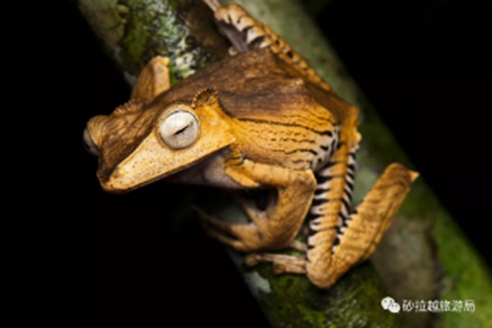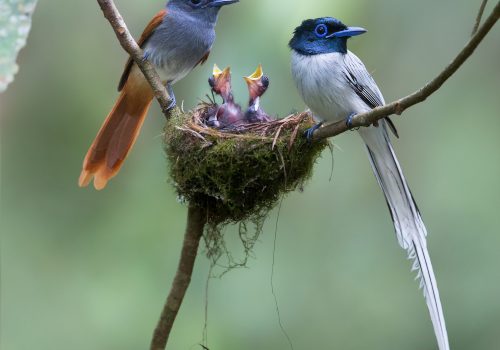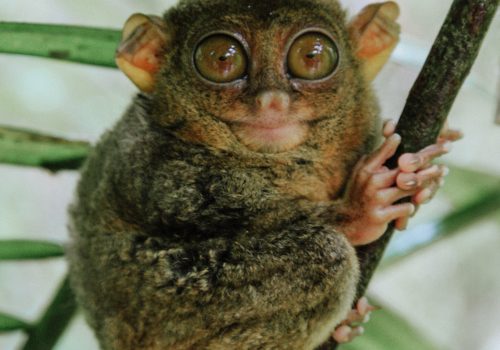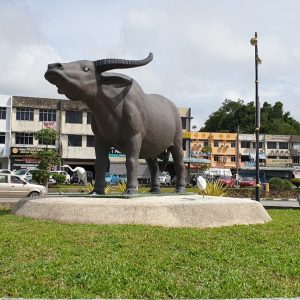Sarawak’s amazing wildlife
Learn more about Sarawak’s wildlife.
Sarawak is a land of hidden treasures. Approximately two-thirds of Sarawak’s land area is covered in dense rainforests. This means that it is home to a large variety of flora and fauna, many of which are endemic to the land. Let us look at some of these wildlife that call Sarawak home.
 Caption: The orangutan is one of the endemic animals that call Sarawak home. Source: STB Photo Library |
Borneon eared tree frog
Sarawak’s Kubah National Park is home to a large tree frog with a huge head and an unusually small and flat body. The Borneon eared tree frog lives in the lowland rainforest, clinging on plants measuring just a few meters from the ground.
 A Borneon eared tree frog with long, slender body. Picture from: Shen Jingchen |
The Borneon eared tree frog has a protruding ridge above its tympanic membrane, making it look as if it has a pair of small ears. Its back is light yellow-brown in colour, decorated with dark brown stripes forming a natural protective camouflage that looks like the grains of a tree. This frog is also commonly known as wood-grain frog.
Wallace’s flying frog
Sarawak is also home to the Wallace’s flying frog. This celebrity frog has webs on its feet and the smooth skin between its limbs allow it to glide effortlessly among trees. This allows the frog to avoid predators and hunt for food conveniently.
 The Wallace’s flying frog has webs on its feet and the smooth skin between its limbs allows it to glide among the trees. Source: STB Photo Library |
Borneo bearded pig
The Borneon bearded pig can be identified by the beards from the bridge of the nose to the sides of its head, all the way to the chin. Males have thicker beards. The lusher the beard, the more attractive he is with the females.
 The Borneon bearded pig has a face full of hair to help it filter dirt and mud when foraging for food. Source: STB Photo Library |
The beards are also useful when foraging in humid tropical rainforests, mangroves, and beaches where the pigs live. The bushy beard acts like a barrier when they get their face covered with mud as they dig. It prevents mud and water from splashing into the eyes and mouth of the animals.
Hornbill
The hornbill is synonymous with Sarawak. There are eight different types of hornbills that call Sarawak home. The locals believe that the Hornbill is a messenger sent by the gods to bring news to the spiritual world. Hornbills are omnivorous birds that feed on fruits, insects and small mammals. They generally live on towering trees deep in dense forests.
 The Rhinoceros Hornbill is one of eight species of hornbills that can be found in Sarawak. Source: STB photo library |
Every summer, a pair of hornbills will choose an opening in the trunk of a tall tree as their nest to lay eggs. They will fill up the hole covering with mud after laying eggs, leaving a hole that is only wide enough for the female bird to stick out the tip of her beak.
The male hornbill is responsible for providing nourishment for both the female and the young.
Mouse-deer
The mouse-deer is also known as the “spirit of the forest”. It is miniature in size, measuring only 30 cm in length. It is the smallest hoofed animal in the world. Its head resembles a mouse, and its body resembles a deer.
 Mouse-deer that looks like a mouse and a deer |
What’s even more amazing is that this pocket-sized animal has excellent reproductive ability. Female deer may conceive within two hours after birth, and baby mouse-deer can stand upright 30 minutes after birth.
Clouded leopard
The clouded leopard is one of the oldest in evolutionary history among the cat family. Clouded leopards are very secretive and illusive, making them difficult to track and study. It is nocturnal and is usually active at night, preying on smaller mammals such as deer, pigs, and even monkeys.
 Image source: 新浪网@动物速递 |
Bornean slow loris
The Bornean slow loris is classified as a primate, but it looks more like a little lemur. The Bornean slow loris is usually active at night, perching on top of trees, moving very slowly.
 Bornean slow loris on the treetop Image source: Instagram@jonathan_beilby |
When threatened, the Borneon slow loris will secrete a brown oily substance under their armpits, which – when mixed with their saliva – forms a toxic shield to protect themselves. Only those living in the wild is able to secrete normal levels of this toxic substance as the toxin is produced by eating poisonous insects, such as centipedes and scorpions.
Rafflesia
Sarawak’s wildlife is not limited to just animals. The Rafflesia is classified as the world’s largest flower and it has an odour to match.
Legend has it that there once lived a large girl with a stench so repulsive that no one wanted to approach her. One day, she fell in love with a handsome young man but the man’s parents did not approve of her because of her stench
The young man was however determined to marry her. The girl couldn’t bear to see the man she loves falling out with his parents so she went to a small hill alone and blessed the man silently. She stood there for seven days and seven nights and eventually turned into a very big flower, which smelled just as bad as she did. She was later discovered and named Rafflesia.
 The Rafflesia is classified as the largest flower in the world. Source: STB Photo Library |
Want to learn more about these organisms and see them up close in person? Drop by Sarawak and see them with your own eyes.














